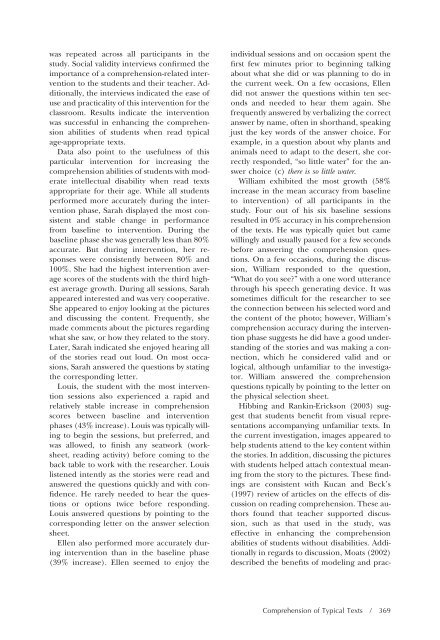etadd_47(3) - Division on Autism and Developmental Disabilities
etadd_47(3) - Division on Autism and Developmental Disabilities
etadd_47(3) - Division on Autism and Developmental Disabilities
You also want an ePaper? Increase the reach of your titles
YUMPU automatically turns print PDFs into web optimized ePapers that Google loves.
was repeated across all participants in the<br />
study. Social validity interviews c<strong>on</strong>firmed the<br />
importance of a comprehensi<strong>on</strong>-related interventi<strong>on</strong><br />
to the students <strong>and</strong> their teacher. Additi<strong>on</strong>ally,<br />
the interviews indicated the ease of<br />
use <strong>and</strong> practicality of this interventi<strong>on</strong> for the<br />
classroom. Results indicate the interventi<strong>on</strong><br />
was successful in enhancing the comprehensi<strong>on</strong><br />
abilities of students when read typical<br />
age-appropriate texts.<br />
Data also point to the usefulness of this<br />
particular interventi<strong>on</strong> for increasing the<br />
comprehensi<strong>on</strong> abilities of students with moderate<br />
intellectual disability when read texts<br />
appropriate for their age. While all students<br />
performed more accurately during the interventi<strong>on</strong><br />
phase, Sarah displayed the most c<strong>on</strong>sistent<br />
<strong>and</strong> stable change in performance<br />
from baseline to interventi<strong>on</strong>. During the<br />
baseline phase she was generally less than 80%<br />
accurate. But during interventi<strong>on</strong>, her resp<strong>on</strong>ses<br />
were c<strong>on</strong>sistently between 80% <strong>and</strong><br />
100%. She had the highest interventi<strong>on</strong> average<br />
scores of the students with the third highest<br />
average growth. During all sessi<strong>on</strong>s, Sarah<br />
appeared interested <strong>and</strong> was very cooperative.<br />
She appeared to enjoy looking at the pictures<br />
<strong>and</strong> discussing the c<strong>on</strong>tent. Frequently, she<br />
made comments about the pictures regarding<br />
what she saw, or how they related to the story.<br />
Later, Sarah indicated she enjoyed hearing all<br />
of the stories read out loud. On most occasi<strong>on</strong>s,<br />
Sarah answered the questi<strong>on</strong>s by stating<br />
the corresp<strong>on</strong>ding letter.<br />
Louis, the student with the most interventi<strong>on</strong><br />
sessi<strong>on</strong>s also experienced a rapid <strong>and</strong><br />
relatively stable increase in comprehensi<strong>on</strong><br />
scores between baseline <strong>and</strong> interventi<strong>on</strong><br />
phases (43% increase). Louis was typically willing<br />
to begin the sessi<strong>on</strong>s, but preferred, <strong>and</strong><br />
was allowed, to finish any seatwork (worksheet,<br />
reading activity) before coming to the<br />
back table to work with the researcher. Louis<br />
listened intently as the stories were read <strong>and</strong><br />
answered the questi<strong>on</strong>s quickly <strong>and</strong> with c<strong>on</strong>fidence.<br />
He rarely needed to hear the questi<strong>on</strong>s<br />
or opti<strong>on</strong>s twice before resp<strong>on</strong>ding.<br />
Louis answered questi<strong>on</strong>s by pointing to the<br />
corresp<strong>on</strong>ding letter <strong>on</strong> the answer selecti<strong>on</strong><br />
sheet.<br />
Ellen also performed more accurately during<br />
interventi<strong>on</strong> than in the baseline phase<br />
(39% increase). Ellen seemed to enjoy the<br />
individual sessi<strong>on</strong>s <strong>and</strong> <strong>on</strong> occasi<strong>on</strong> spent the<br />
first few minutes prior to beginning talking<br />
about what she did or was planning to do in<br />
the current week. On a few occasi<strong>on</strong>s, Ellen<br />
did not answer the questi<strong>on</strong>s within ten sec<strong>on</strong>ds<br />
<strong>and</strong> needed to hear them again. She<br />
frequently answered by verbalizing the correct<br />
answer by name, often in shorth<strong>and</strong>, speaking<br />
just the key words of the answer choice. For<br />
example, in a questi<strong>on</strong> about why plants <strong>and</strong><br />
animals need to adapt to the desert, she correctly<br />
resp<strong>on</strong>ded, “so little water” for the answer<br />
choice (c) there is so little water.<br />
William exhibited the most growth (58%<br />
increase in the mean accuracy from baseline<br />
to interventi<strong>on</strong>) of all participants in the<br />
study. Four out of his six baseline sessi<strong>on</strong>s<br />
resulted in 0% accuracy in his comprehensi<strong>on</strong><br />
of the texts. He was typically quiet but came<br />
willingly <strong>and</strong> usually paused for a few sec<strong>on</strong>ds<br />
before answering the comprehensi<strong>on</strong> questi<strong>on</strong>s.<br />
On a few occasi<strong>on</strong>s, during the discussi<strong>on</strong>,<br />
William resp<strong>on</strong>ded to the questi<strong>on</strong>,<br />
“What do you see?” with a <strong>on</strong>e word utterance<br />
through his speech generating device. It was<br />
sometimes difficult for the researcher to see<br />
the c<strong>on</strong>necti<strong>on</strong> between his selected word <strong>and</strong><br />
the c<strong>on</strong>tent of the photo; however, William’s<br />
comprehensi<strong>on</strong> accuracy during the interventi<strong>on</strong><br />
phase suggests he did have a good underst<strong>and</strong>ing<br />
of the stories <strong>and</strong> was making a c<strong>on</strong>necti<strong>on</strong>,<br />
which he c<strong>on</strong>sidered valid <strong>and</strong> or<br />
logical, although unfamiliar to the investigator.<br />
William answered the comprehensi<strong>on</strong><br />
questi<strong>on</strong>s typically by pointing to the letter <strong>on</strong><br />
the physical selecti<strong>on</strong> sheet.<br />
Hibbing <strong>and</strong> Rankin-Ericks<strong>on</strong> (2003) suggest<br />
that students benefit from visual representati<strong>on</strong>s<br />
accompanying unfamiliar texts. In<br />
the current investigati<strong>on</strong>, images appeared to<br />
help students attend to the key c<strong>on</strong>tent within<br />
the stories. In additi<strong>on</strong>, discussing the pictures<br />
with students helped attach c<strong>on</strong>textual meaning<br />
from the story to the pictures. These findings<br />
are c<strong>on</strong>sistent with Kucan <strong>and</strong> Beck’s<br />
(1997) review of articles <strong>on</strong> the effects of discussi<strong>on</strong><br />
<strong>on</strong> reading comprehensi<strong>on</strong>. These authors<br />
found that teacher supported discussi<strong>on</strong>,<br />
such as that used in the study, was<br />
effective in enhancing the comprehensi<strong>on</strong><br />
abilities of students without disabilities. Additi<strong>on</strong>ally<br />
in regards to discussi<strong>on</strong>, Moats (2002)<br />
described the benefits of modeling <strong>and</strong> prac-<br />
Comprehensi<strong>on</strong> of Typical Texts / 369

















